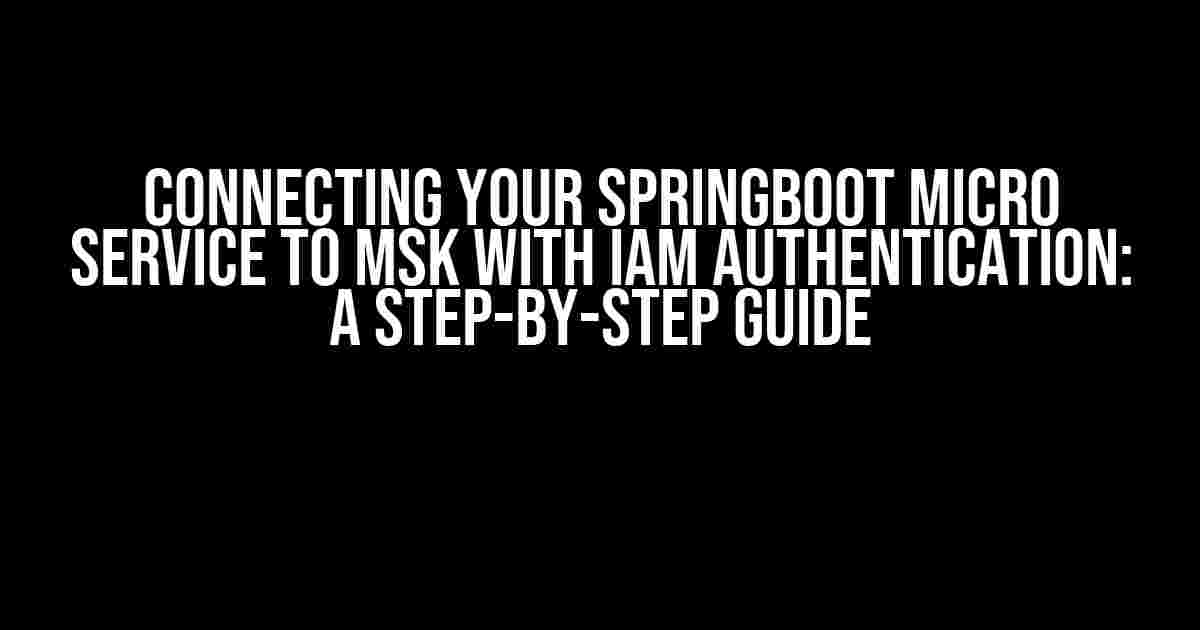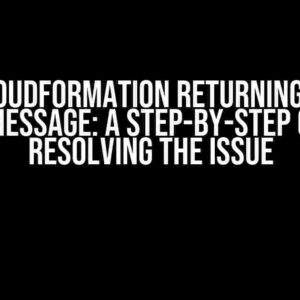Are you struggling to connect your SpringBoot micro service to an Amazon MSK (Managed Streaming for Kafka) cluster with IAM authentication? Look no further! In this article, we’ll take you on a journey to conquer this challenging task with ease. Buckle up, folks, and let’s dive in!
- What is MSK with IAM Authentication?
- Why Do I Need to Connect My SpringBoot Micro Service to MSK with IAM Authentication?
- Prerequisites
- Step 1: Create an IAM Role for Your SpringBoot Micro Service
- Step 2: Configure Your SpringBoot Micro Service to Use the IAM Role
- Step 3: Authenticate with the MSK Cluster Using IAM
- Testing Your Connection
- Conclusion
- Additional Resources
What is MSK with IAM Authentication?
Amazon MSK is a fully managed service that makes it easy to build and run Apache Kafka applications. It provides high availability, scalability, and security for your Kafka clusters. IAM authentication is an additional layer of security that enables you to control access to your MSK cluster using AWS Identity and Access Management (IAM) roles and permissions.
By using IAM authentication, you can grant fine-grained access to your MSK cluster, ensuring that only authorized users and applications can access your data. This is especially important in a microservices architecture, where multiple services interact with each other and with the MSK cluster.
Why Do I Need to Connect My SpringBoot Micro Service to MSK with IAM Authentication?
In a microservices architecture, each service is designed to perform a specific task and communicate with other services to achieve a common goal. Your SpringBoot micro service is likely one of these services, and it needs to interact with the MSK cluster to produce or consume data.
By connecting your SpringBoot micro service to MSK with IAM authentication, you ensure that:
- Your service can access the MSK cluster securely, without exposing sensitive credentials.
- You can control access to your MSK cluster, ensuring that only authorized services and users can interact with it.
- You can monitor and audit access to your MSK cluster, detecting potential security breaches and unauthorized access.
Prerequisites
Before we dive into the implementation details, make sure you have the following:
- An AWS account with an active MSK cluster.
- A SpringBoot micro service project set up with Maven or Gradle.
- The AWS SDK for Java and the Kafka client library installed in your project.
- A basic understanding of IAM roles and permissions.
Step 1: Create an IAM Role for Your SpringBoot Micro Service
In this step, we’ll create an IAM role that your SpringBoot micro service can assume to access the MSK cluster. This role will have the necessary permissions to interact with the MSK cluster.
- Log in to the AWS Management Console and navigate to the IAM dashboard.
- Click on “Roles” and then “Create role”.
- Choose “Custom role” and give your role a name, such as “msk-access-role”.
- Attach the following policies to your role:
| Policy | Description |
|---|---|
| AmazonMSKReadOnlyAccess | Grants read-only access to the MSK cluster. |
| AmazonMSKFullAccess | Grants full access to the MSK cluster. |
| CloudWatchLogsReadOnlyAccess | Grants read-only access to CloudWatch logs. |
Note: You can customize the policies to fit your specific needs, but the above policies should provide sufficient access for most use cases.
Step 2: Configure Your SpringBoot Micro Service to Use the IAM Role
In this step, we’ll configure your SpringBoot micro service to use the IAM role we created earlier.
import software.amazon.awssdk.auth.credentials.AwsCredentialsProvider;
import software.amazon.awssdk.auth.credentials.DefaultCredentialsProvider;
import software.amazon.awssdk.services.kafka.KafkaClient;
import software.amazon.awssdk.services.kafka.model.BootstrapBrokers;
// Create an instance of the Kafka client
KafkaClient kafkaClient = KafkaClient.create();
// Create an instance of the AWS credentials provider
AwsCredentialsProvider credentialsProvider = DefaultCredentialsProvider.create();
// Create a Kafka bootstrap broker
BootstrapBrokers bootstrapBrokers = BootstrapBrokers.builder()
.bootstrapBrokers("your-msk-cluster-url")
.build();
// Create a Kafka producer
Producer producer = new KafkaProducer<>(bootstrapBrokers, credentialsProvider);
Note: Make sure to replace “your-msk-cluster-url” with the URL of your MSK cluster.
Step 3: Authenticate with the MSK Cluster Using IAM
In this step, we’ll authenticate with the MSK cluster using the IAM role and credentials provider.
import software.amazon.awssdk.services.securitytoken.SecurityTokenServiceClient;
import software.amazon.awssdk.services.securitytoken.model.GetCallerIdentityRequest;
import software.amazon.awssdk.services.securitytoken.model.GetCallerIdentityResponse;
// Create an instance of the security token service client
SecurityTokenServiceClient securityTokenServiceClient = SecurityTokenServiceClient.create();
// Get the caller identity (IAM role)
GetCallerIdentityResponse callerIdentityResponse = securityTokenServiceClient.getCallerIdentity(GetCallerIdentityRequest.builder().build());
// Get the IAM role ARN
String iamRoleArn = callerIdentityResponse.arn();
// Create a Kafka client properties object
Properties props = new Properties();
props.put("bootstrap.servers", "your-msk-cluster-url");
props.put("security.protocol", "SASL_SSL");
props.put("sasl.mechanism", "AWS_MSK_IAM");
props.put("sasl.jaas.config", "software.amazon.msk.auth.iam.IAMLoginModule required;");
props.put("sasl.client.callback.handler.class", "software.amazon.msk.auth.iam.IAMClientCallbackHandler");
props.put("aws_MSK_iam.arn", iamRoleArn);
// Create a Kafka producer with the IAM authentication properties
Producer producer = new KafkaProducer<>(props);
Note: Make sure to replace “your-msk-cluster-url” with the URL of your MSK cluster.
Testing Your Connection
Now that we’ve configured our SpringBoot micro service to connect to the MSK cluster with IAM authentication, let’s test it out!
// Produce a message to the MSK cluster
producer.send(new ProducerRecord<>("your-topic-name", "Hello, MSK!")).get();
// Verify that the message was successfully sent
System.out.println("Message sent to MSK cluster!");
Note: Make sure to replace “your-topic-name” with the name of an existing topic in your MSK cluster.
Conclusion
In this article, we’ve shown you how to connect your SpringBoot micro service to an MSK cluster with IAM authentication. By following these steps, you can ensure secure and controlled access to your MSK cluster, while also leveraging the benefits of IAM roles and permissions.
Remember to customize the policies and configurations to fit your specific use case, and don’t hesitate to reach out if you have any questions or need further assistance.
Happy coding, and may the MSK be with you!
Additional Resources
For more information on MSK with IAM authentication, check out the following resources:
Frequently Asked Question
Connecting your Spring Boot microservice to an MSK (Managed Streaming for Kafka) instance with IAM (Identity and Access Management) authentication can be a bit tricky, but don’t worry, we’ve got you covered!
What dependencies do I need to add to my Spring Boot project to connect to MSK with IAM authentication?
You’ll need to add the following dependencies to your Spring Boot project: `spring-cloud-starter-aws` and `org.apache.kafka:kafka-clients`. The `spring-cloud-starter-aws` dependency will provide the necessary AWS SDK for Java, and the `kafka-clients` dependency will allow you to interact with your MSK instance.
How do I configure my Spring Boot application to use IAM authentication with MSK?
To configure your Spring Boot application to use IAM authentication with MSK, you’ll need to create an `AWS_MSK_IAM` credentials provider in your application configuration. You can do this by creating a `@Configuration` class and adding the necessary configuration properties. For example: `AWS_MSK_IAM={access-key-id}:{secret-access-key}:{session-token}`.
What are the necessary IAM permissions required for my Spring Boot application to connect to MSK?
Your Spring Boot application will need the following IAM permissions to connect to MSK: `kafka:CreateTopic`, `kafka:DescribeTopic`, `kafka:Publish`, `kafka:Subscribe`, and `kafka:Consume`. You can create an IAM role with these permissions and assign it to your application.
How do I handle IAM credentials rotation for my Spring Boot application?
To handle IAM credentials rotation, you can use the `aws-sts` dependency in your Spring Boot project. This dependency will allow you to automatically rotate your IAM credentials using the AWS Security Token Service (STS). You can configure your application to use the `aws-sts` dependency by creating an `AWS_STS` credentials provider.
What’s the best practice for securing my Spring Boot application when connecting to MSK with IAM authentication?
The best practice for securing your Spring Boot application when connecting to MSK with IAM authentication is to use a secure configuration management system, such as AWS Secrets Manager or HashiCorp’s Vault, to store and manage your IAM credentials. Additionally, make sure to use the latest TLS version and encrypt all data in transit.



